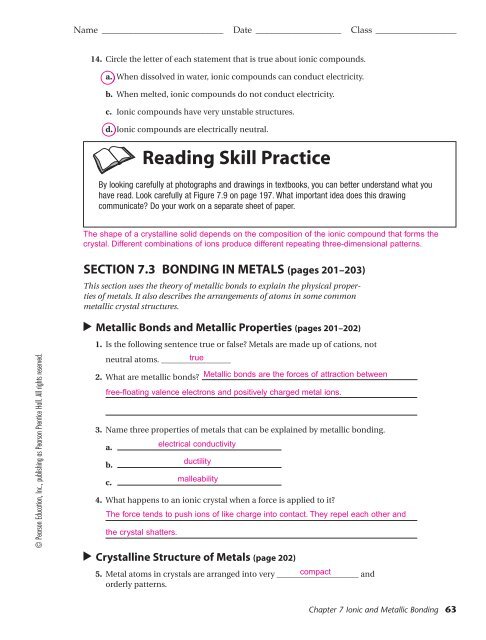KEY-FinalExamStudyGuide_Fall2013
KEY-FinalExamStudyGuide_Fall2013
KEY-FinalExamStudyGuide_Fall2013
You also want an ePaper? Increase the reach of your titles
YUMPU automatically turns print PDFs into web optimized ePapers that Google loves.
Name ___________________________ Date ___________________ Class __________________<br />
14. Circle the letter of each statement that is true about ionic compounds.<br />
a. When dissolved in water, ionic compounds can conduct electricity.<br />
b. When melted, ionic compounds do not conduct electricity.<br />
c. Ionic compounds have very unstable structures.<br />
d. Ionic compounds are electrically neutral.<br />
Reading Skill Practice<br />
By looking carefully at photographs and drawings in textbooks, you can better understand what you<br />
have read. Look carefully at Figure 7.9 on page 197. What important idea does this drawing<br />
communicate? Do your work on a separate sheet of paper.<br />
The shape of a crystalline solid depends on the composition of the ionic compound that forms the<br />
crystal. Different combinations of ions produce different repeating three-dimensional patterns.<br />
SECTION 7.3 BONDING IN METALS (pages 201–203)<br />
This section uses the theory of metallic bonds to explain the physical properties<br />
of metals. It also describes the arrangements of atoms in some common<br />
metallic crystal structures.<br />
© Pearson Education, Inc., publishing as Pearson Prentice Hall. All rights reserved.<br />
Metallic Bonds and Metallic Properties (pages 201–202)<br />
1. Is the following sentence true or false? Metals are made up of cations, not<br />
neutral atoms. _________________<br />
true<br />
2. What are metallic bonds? Metallic bonds are the forces of attraction between<br />
free-floating valence electrons and positively charged metal ions.<br />
3. Name three properties of metals that can be explained by metallic bonding.<br />
a.<br />
b.<br />
c.<br />
electrical conductivity<br />
ductility<br />
malleability<br />
4. What happens to an ionic crystal when a force is applied to it?<br />
The force tends to push ions of like charge into contact. They repel each other and<br />
the crystal shatters.<br />
Crystalline Structure of Metals (page 202)<br />
5. Metal atoms in crystals are arranged into very ____________________ compact and<br />
orderly patterns.<br />
Chapter 7 Ionic and Metallic Bonding 63


